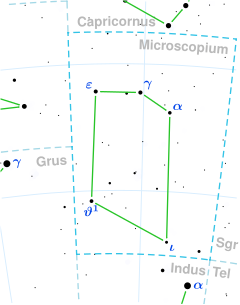Iota Microscopii
| Observation data Epoch J2000 Equinox J2000 | |
|---|---|
| Constellation | Microscopium |
| Right ascension | 20h 48m 29.13901s[1] |
| Declination | −43° 59′ 18.7397″[1] |
| Apparent magnitude (V) | 5.11[2] |
| Characteristics | |
| Spectral type | F1IV[3] |
| U−B color index | +0.04[4] |
| B−V color index | +0.35[5] |
| Astrometry | |
| Radial velocity (Rv) | -14.90[6] km/s |
| Proper motion (μ) | RA: +172.34[1] mas/yr Dec.: -109.61[1] mas/yr |
| Parallax (π) | 28.23 ± 0.99 mas[1] |
| Distance | 116 ± 4 ly (35 ± 1 pc) |
| Absolute magnitude (MV) | 2.05[2] |
| Details | |
| Mass | 1.67[7] M☉ |
| Radius | 2.4[7] R☉ |
| Luminosity | 12.65[2] L☉ |
| Surface gravity (log g) | 3.90[8] cgs |
| Temperature | 6,997[8] K |
| Metallicity [Fe/H] | -0.03[2] dex |
| Rotational velocity (v sin i) | 84[3] km/s |
| Other designations | |
| Database references | |
| SIMBAD | data |
Iota Microscopii (ι Mic) is a class F1IV[3] (yellow-white subgiant) star in the constellation Microscopium. Its apparent magnitude is 5.11[2] and it is approximately 116 light years away based on parallax.[1]
It has one companion, first observed in 1932, with a separation of 4.3" and a visual magnitude of 15.5.[9]
References
- ^ a b c d e f Van Leeuwen, F. (2007). "Validation of the new Hipparcos reduction". Astronomy and Astrophysics. 474 (2): 653. arXiv:0708.1752. Bibcode:2007A&A...474..653V. doi:10.1051/0004-6361:20078357. Vizier catalog entry
- ^ a b c d e Anderson, E.; Francis, Ch. (2012). "XHIP: An extended hipparcos compilation". Astronomy Letters. 38 (5): 331. arXiv:1108.4971. Bibcode:2012AstL...38..331A. doi:10.1134/S1063773712050015. Vizier catalog entry
- ^ a b c Hoffleit, D.; Warren, W. H. (1995). "VizieR Online Data Catalog: Bright Star Catalogue, 5th Revised Ed. (Hoffleit+, 1991)". VizieR On-line Data Catalog: V/50. Originally published in: 1964BS....C......0H. 5050. Bibcode:1995yCat.5050....0H.
- ^ Mermilliod, J. C. (2006). "VizieR Online Data Catalog: Homogeneous Means in the UBV System (Mermilliod 1991)". VizieR On-line Data Catalog: II/168. Originally published in: Institut d'Astronomie. 2168. Bibcode:2006yCat.2168....0M.Vizier catalog entry
- ^ Mallama, A. (2014). "Sloan Magnitudes for the Brightest Stars". The Journal of the American Association of Variable Star Observers. 42: 443. Bibcode:2014JAVSO..42..443M.Vizier catalog entry
- ^ Gontcharov, G. A. (2006). "Pulkovo Compilation of Radial Velocities for 35 495 Hipparcos stars in a common system". Astronomy Letters. 32 (11): 759. arXiv:1606.08053. Bibcode:2006AstL...32..759G. doi:10.1134/S1063773706110065.
- ^ a b Allende Prieto, C.; Lambert, D. L. (1999). "Fundamental parameters of nearby stars from the comparison with evolutionary calculations: Masses, radii and effective temperatures". Astronomy and Astrophysics. 352: 555. arXiv:astro-ph/9911002. Bibcode:1999A&A...352..555A. Vizier catalog entry
- ^ a b David, Trevor J.; Hillenbrand, Lynne A. (2015). "The Ages of Early-Type Stars: Strömgren Photometric Methods Calibrated, Validated, Tested, and Applied to Hosts and Prospective Hosts of Directly Imaged Exoplanets". The Astrophysical Journal. 804 (2): 146. arXiv:1501.03154. Bibcode:2015ApJ...804..146D. doi:10.1088/0004-637X/804/2/146. Vizier catalog entry
- ^ Mason, Brian D.; Wycoff, Gary L.; Hartkopf, William I.; Douglass, Geoffrey G.; Worley, Charles E. (2001). "The 2001 US Naval Observatory Double Star CD-ROM. I. The Washington Double Star Catalog". The Astronomical Journal. 122 (6): 3466. Bibcode:2001AJ....122.3466M. doi:10.1086/323920. Vizier catalog entry

